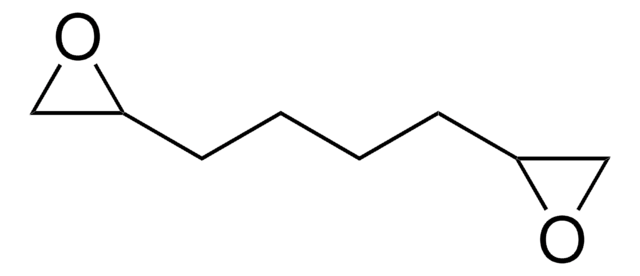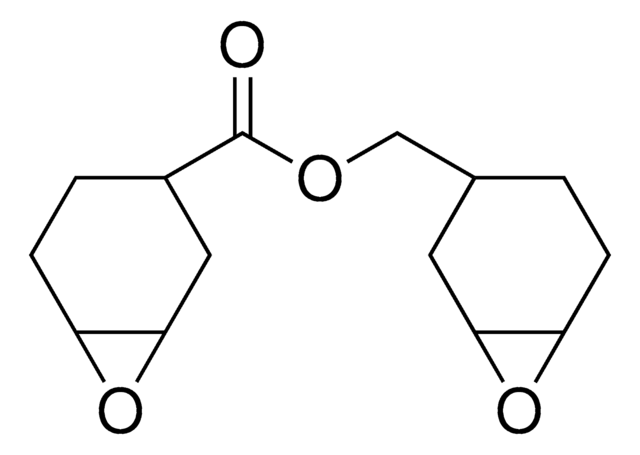The identity of the other 40% of the material is not determined. Typically, these impurities are other diepoxide isomers, but they may not be the only impurities. For a higher purity 1,4-Butanediol diglycidyl ether, the material listed under product number 220892 is recommended, which has a purity of ≥ 95.0%.
124192
1,4-butandiolo diglicidil etere
technical grade, 60%
Sinonimo/i:
1,4-Bis(2,3-epoxypropoxy)butane, 1,4-Bis(glycidyloxy)butane, 1,4-Bis(oxiran-2-ylmethoxy)butane, 1,4-Butylene glycol diglycidyl ether, Tetramethylene glycol diglycidyl ether
Scegli un formato
Scegli un formato
About This Item
Prodotti consigliati
Grado
technical grade
Tensione di vapore
~10 mmHg ( 20 °C)
Stato
liquid
Concentrazione
60%
Indice di rifrazione
n20/D 1.453 (lit.)
P. ebollizione
266 °C (lit.)
Densità
1.1 g/mL at 25 °C (lit.)
Stringa SMILE
C(CCOCC1CO1)COCC2CO2
InChI
1S/C10H18O4/c1(3-11-5-9-7-13-9)2-4-12-6-10-8-14-10/h9-10H,1-8H2
SHKUUQIDMUMQQK-UHFFFAOYSA-N
Cerchi prodotti simili? Visita Guida al confronto tra prodotti
Categorie correlate
Descrizione generale
Applicazioni
- As a cross-linking agent to prepare hyaluronic acid dermal fillers This crosslinking process enhances the gel-like consistency of the filler, making it more durable and longer-lasting.[1]
- As a monomer to prepare epoxy-based graphene nanocomposites that have potential applications in the field of flexible electronics, corrosion resistance coatings, and conductive adhesives. BDDE is chosen for its desirable properties such as low viscosity, good reactivity, and compatibility with graphene.
Avvertenze
Danger
Indicazioni di pericolo
Classi di pericolo
Acute Tox. 4 Dermal - Acute Tox. 4 Inhalation - Acute Tox. 4 Oral - Aquatic Chronic 3 - Eye Dam. 1 - Skin Irrit. 2 - Skin Sens. 1
Codice della classe di stoccaggio
10 - Combustible liquids
Classe di pericolosità dell'acqua (WGK)
WGK 2
Punto d’infiammabilità (°F)
235.4 °F - closed cup
Punto d’infiammabilità (°C)
113 °C - closed cup
Dispositivi di protezione individuale
Eyeshields, Faceshields, Gloves, type ABEK (EN14387) respirator filter
Scegli una delle versioni più recenti:
Possiedi già questo prodotto?
I documenti relativi ai prodotti acquistati recentemente sono disponibili nell’Archivio dei documenti.
-
Product listed as 60%, but what is the make up of the remaining 40%? Is it dissolved in something?
1 answer-
Helpful?
-
Active Filters
Il team dei nostri ricercatori vanta grande esperienza in tutte le aree della ricerca quali Life Science, scienza dei materiali, sintesi chimica, cromatografia, discipline analitiche, ecc..
Contatta l'Assistenza Tecnica.









